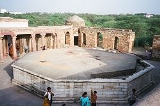
Sultan Ghari
Encyclopedia
Sultan Ghari was the first Islamic Mausoleum
(tomb) built in 1231 AD for Prince Nasiru'd-Din Mahmud
, eldest son of Iltumish, in the “funerary landscape of Delhi
” in the Malakapur village (near Vasant Kunj
). Iltumish was the first Sultan of the Slave Dynasty who ruled in Delhi from 1210 to 1236 AD. The area where the Ghari (meaning: cave) tomb is situated, was part of the first city of medieval Delhi known as the Slave Dynasty
that ruled during the period 1206 to 1290.This area is now part of the Qutb complex
. The Slave Dynasty was the forerunner under the early Delhi Sultanate
that ruled from 1216 to 1516. This dynastic city was followed by creation of other five cities of Delhi ruled by different dynastic rulers of the Delhi Sultanate, namely, the Khilji dynasty
(1290–1320), the Tughlaq dynasty
(1320–1413), the Sayyid dynasty
(1414–51), and the Lodi dynasty (1451–1526). The rule of the Mughal Empire
then followed and lasted from 1526 to 1857.
The crypt
or the tomb is implanted in a Ghari (cave), approached by winding steep stairs made of stone, and supported by pillars and flooring. The cave is covered by an unusual octagonal roof
slab
. The exterior of the tomb structure built in Delhi sandstone
with marble
adornment exhibits a walled area with bastions (towers) on corners, which impart it the look of a fortress in aesthetic Persian
and Oriental architecture
. The other tombs inside the Ghari have not been identified.
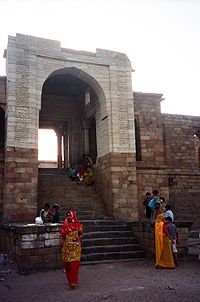 Iltumish, ruling from Delhi since 1210 AD, invaded eastern India in 1225 AD to capture Lakhnauti (now a ruined city in West Bengal
Iltumish, ruling from Delhi since 1210 AD, invaded eastern India in 1225 AD to capture Lakhnauti (now a ruined city in West Bengal
called Gaur
). The resultant battle ended in signing of a treaty
between Izaz, the then ruler of Eastern India (Bihar
and Bengal
) and Iltumish; the former ruler agreeing to pay a surety of 80 lakh tankas (silver currency), 38 elephants, mint and issue of coins in the name of Iltumish and accepting Sultan’s suzerainty over the region. Before returning to Delhi, Iltumish divided the region into Bihar and Lakhnauti, and installed Alauddin masud jani as his feudatory in Lakhnauti. But Jani’s control was short lived as he was overthrown by Iwaz soon after Iltumish’s departure.
Thereafter, Iltutmish deputed his eldest son prince Nasiru'd-Din Mahmud to fight Iwaz. In the battle which took place near Lakhnauti, Iwaz was trounced and executed in 1227 AD, along with his nobles. Prince Nasiru'd-Din Mahmud, who was then appointed as governor of Lakhnauti province, merged his original province of Oudh with Bengal and Bihar, and established his capital at Lakhnauti. This act of his coupled with the fact that he was son of Iltumish enhanced his prestige in the province. As a reward, he was given the honorific title of ‘Malik-us-Sharq' (king of the East) by Iltutmish. His rule was short lived, eventful and he could consolidate his territory. But after a rule of 18 months, Nasiru'd-Din Mahmud was killed. Immensely grieved by the death of his favourite eldest son, Iltumish built a tomb called the Sultan Ghari in memory of his son, in 1231 AD, close to the Qutb complex
. Five years later, Iltumish died in 1236 and his tomb can be seen in the Qutb complex. His two other sons, namely Ruknuddin Feroze Shah (died 1237 AD, after he was deposed) and Muizzudin Bahram Shah (was killed in 1241 AD) who ruled for short periods, before and after their famous sister Razia Sultan ruled Delhi, were also buried in separate Chhatri
s (cenotaphs), just next to the Sultan Ghari. One of the two Chhatris (pictured) is restored while the other has been destroyed.
Some archaeological findings reported by the Archeological Survey of India are a) the inscription of 1361 recording the excavation of a tank on the occasion of a marriage, b) a stone linga (phallic symbol of Lord Shiva
the Hindu
God in a lintel and c) a dilapidated mosque
of Sultan Feroz Shah Tughlaq's time and a few scattered remnants of the Mughal
period.
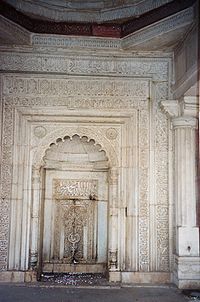 The plan of the tomb structure is unusual. It is in the form of a fortress with a courtyard like layout, not common among tombs. It is built over a raised plinth of certain height in rubble masonry work. The octagonal shape of the tomb is also unique as it has been built within the fortress like outer structure with four corner towers, over a Ghari (cave) in front of the western Qibla
The plan of the tomb structure is unusual. It is in the form of a fortress with a courtyard like layout, not common among tombs. It is built over a raised plinth of certain height in rubble masonry work. The octagonal shape of the tomb is also unique as it has been built within the fortress like outer structure with four corner towers, over a Ghari (cave) in front of the western Qibla
wall of the mosque. It, thus, is a combination of an over ground tomb with towers (which is common in most of the tombs) and an underground chamber for the crypt.
The octagonal grave–chamber with the crypt (tomb) in an underground opening is supported on four columns raised with two pillars each that support beams, and depict ancient Indian temple relics both on the columns and on the floor. The roof of the chamber is built in thick lime–concrete. The western qibla
(prayer wall) which has the mihrab
, is made of marble in exquisite Turkish
and Afghan
design. The marble mihrab also has inscriptions from the Quran. The front elevation of this west wall has a marble facade, dated to Feroze Shah's rule (1351–88). The prayer chamber in front of the qibla depicts a yoni-patta (the base slab of a Linga.
The entire tomb depicts a trabeate or corbel arch
construction, which was common in India before the true arch design of the Romans
was introduced, which are seen in subsequent Islamic monuments.
Feroz Shah Tughlaq (1351–1388 AD) is credited to have repaired the tomb, which had been substantially damaged. The Chhatri
, a stand alone structure, next to the Sultan Garhi, a tomb of one of the two sons of Iltumish, was also restored during Firuz Shah’s reign.
Old village ruins surround the tomb. Old ruins of a Tugluq mosque, Jami masjid and a khanqah
(a place of spiritual retreat) are also located on the southern side of the tomb.
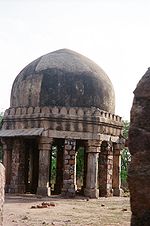 .
.
The tomb is a revered place for devotees of both Hindu
and Muslim
religious communities of the nearby villages of Mahipalpur and Rangpur since they consider the tomb as the dargah
of a saintly ‘peer’; a visit to the tomb is more or less mandatory for newlyweds from these two villages. Because of the religious veneration, the monument is maintained better by the local people than the Archeological Survey of India who are the formal custodians to maintain the heritage structure.
Thursday is a special day for worship at this tomb when devotees, both Hindus and Muslims, visit the shrine, which represents a festive display of Hindu – Muslim syncretism of religious tolerance. Every year, on the 17th day of the Islamic month of Ziqad (month occurring between Ramadan and Eid festivals), the “Urs (death anniversary) of Nasiruddin Shah” is held when pilgrims from all parts of Delhi visit the tomb.
has undertaken the following construction activities :
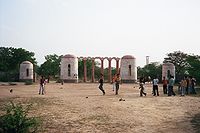
Sultan Ghari is located near Malakpur Kohli village on the Mehrauli
–Palam Road, 8 km west of Qutb complex from Andheria More in present day South Delhi
. The C–Block of Vasant Kunj
, a modern suburb of Delhi, is just across the tomb.
Mausoleum
A mausoleum is an external free-standing building constructed as a monument enclosing the interment space or burial chamber of a deceased person or persons. A monument without the interment is a cenotaph. A mausoleum may be considered a type of tomb or the tomb may be considered to be within the...
(tomb) built in 1231 AD for Prince Nasiru'd-Din Mahmud
Nasir ud din Mahmud
Nasir ud din Mahmud, Nasir ud din Firuz Shah was the eighth sultan of the Mamluk Sultanate . He was the youngest son of Shams ud din Iltutmish , and he succeeded Ala ud din Masud after the chiefs replaced Masud when they felt that he began to behave as a tyrant.As a ruler, Mahmud was known to be...
, eldest son of Iltumish, in the “funerary landscape of Delhi
Delhi
Delhi , officially National Capital Territory of Delhi , is the largest metropolis by area and the second-largest by population in India, next to Mumbai. It is the eighth largest metropolis in the world by population with 16,753,265 inhabitants in the Territory at the 2011 Census...
” in the Malakapur village (near Vasant Kunj
Vasant Kunj
Vasant Kunj is an upmarket residential colony located in South West Delhi district of Delhi, India, on the hills of Aravali, which today has well over 100,000 residents...
). Iltumish was the first Sultan of the Slave Dynasty who ruled in Delhi from 1210 to 1236 AD. The area where the Ghari (meaning: cave) tomb is situated, was part of the first city of medieval Delhi known as the Slave Dynasty
Slave dynasty
The Slave Dynasty or Mamluk Dynasty or Ghulam Dynasty , was directed into India by Qutb-ud-din Aybak, a Turkic general of Central Asian birth. It was the first of five unrelated dynasties to rule India's Delhi Sultanate from 1206 to 1290...
that ruled during the period 1206 to 1290.This area is now part of the Qutb complex
Qutb complex
The Qutb complex , also spelled Qutab or Qutub, is an array of monuments and buildings at Mehrauli in Delhi, India. The construction of Qutb Minar was intended as a Victory Tower, to celebrate the victory of Mohammed Ghori over Rajput king, Prithviraj Chauhan, in 1192 AD, by his then viceroy,...
. The Slave Dynasty was the forerunner under the early Delhi Sultanate
Delhi Sultanate
The Delhi Sultanate is a term used to cover five short-lived, Delhi based kingdoms or sultanates, of Turkic origin in medieval India. The sultanates ruled from Delhi between 1206 and 1526, when the last was replaced by the Mughal dynasty...
that ruled from 1216 to 1516. This dynastic city was followed by creation of other five cities of Delhi ruled by different dynastic rulers of the Delhi Sultanate, namely, the Khilji dynasty
Khilji dynasty
The Khilji Sultanate was a dynasty of Turko-Afghan Khalaj origin who ruled large parts of South Asia from 1290 - 1320. They were the second dynasty to rule the Delhi Sultanate of India...
(1290–1320), the Tughlaq dynasty
Tughlaq dynasty
The Tughlaq dynasty of north India started in 1321 in Delhi when Ghazi Malik assumed the throne under the title of Ghiyath al-Din Tughluq. The Tughluqs were a Muslim family of Turkic origin...
(1320–1413), the Sayyid dynasty
Sayyid dynasty
The Sayyid dynasty ruled Delhi sultanate in India from 1414 to 1451. They succeeded the Tughlaq dynasty and ruled that sultanate until they were displaced by the Lodi dynasty.This family claimed to be Sayyids, or descendants of Prophet Muhammad...
(1414–51), and the Lodi dynasty (1451–1526). The rule of the Mughal Empire
Mughal Empire
The Mughal Empire , or Mogul Empire in traditional English usage, was an imperial power from the Indian Subcontinent. The Mughal emperors were descendants of the Timurids...
then followed and lasted from 1526 to 1857.
The crypt
Crypt
In architecture, a crypt is a stone chamber or vault beneath the floor of a burial vault possibly containing sarcophagi, coffins or relics....
or the tomb is implanted in a Ghari (cave), approached by winding steep stairs made of stone, and supported by pillars and flooring. The cave is covered by an unusual octagonal roof
Roof
A roof is the covering on the uppermost part of a building. A roof protects the building and its contents from the effects of weather. Structures that require roofs range from a letter box to a cathedral or stadium, dwellings being the most numerous....
slab
Slab
-Physical materials:* Slab , a length of metal* Concrete slab, a flat plate used in construction* A piece of stone or concrete used to pave sidewalks or road surfaces* Slab : That portion of a tectonic plate that is subducting...
. The exterior of the tomb structure built in Delhi sandstone
Sandstone
Sandstone is a sedimentary rock composed mainly of sand-sized minerals or rock grains.Most sandstone is composed of quartz and/or feldspar because these are the most common minerals in the Earth's crust. Like sand, sandstone may be any colour, but the most common colours are tan, brown, yellow,...
with marble
Marble
Marble is a metamorphic rock composed of recrystallized carbonate minerals, most commonly calcite or dolomite.Geologists use the term "marble" to refer to metamorphosed limestone; however stonemasons use the term more broadly to encompass unmetamorphosed limestone.Marble is commonly used for...
adornment exhibits a walled area with bastions (towers) on corners, which impart it the look of a fortress in aesthetic Persian
Persian people
The Persian people are part of the Iranian peoples who speak the modern Persian language and closely akin Iranian dialects and languages. The origin of the ethnic Iranian/Persian peoples are traced to the Ancient Iranian peoples, who were part of the ancient Indo-Iranians and themselves part of...
and Oriental architecture
Architecture
Architecture is both the process and product of planning, designing and construction. Architectural works, in the material form of buildings, are often perceived as cultural and political symbols and as works of art...
. The other tombs inside the Ghari have not been identified.
History

West Bengal
West Bengal is a state in the eastern region of India and is the nation's fourth-most populous. It is also the seventh-most populous sub-national entity in the world, with over 91 million inhabitants. A major agricultural producer, West Bengal is the sixth-largest contributor to India's GDP...
called Gaur
Gaur
The gaur , also called Indian bison, is a large bovine native to South Asia and Southeast Asia. The species is listed as vulnerable on the IUCN Red List since 1986 as the population decline in parts of the species' range is likely to be well over 70% over the last three generations...
). The resultant battle ended in signing of a treaty
Treaty
A treaty is an express agreement under international law entered into by actors in international law, namely sovereign states and international organizations. A treaty may also be known as an agreement, protocol, covenant, convention or exchange of letters, among other terms...
between Izaz, the then ruler of Eastern India (Bihar
Bihar
Bihar is a state in eastern India. It is the 12th largest state in terms of geographical size at and 3rd largest by population. Almost 58% of Biharis are below the age of 25, which is the highest proportion in India....
and Bengal
Bengal
Bengal is a historical and geographical region in the northeast region of the Indian Subcontinent at the apex of the Bay of Bengal. Today, it is mainly divided between the sovereign land of People's Republic of Bangladesh and the Indian state of West Bengal, although some regions of the previous...
) and Iltumish; the former ruler agreeing to pay a surety of 80 lakh tankas (silver currency), 38 elephants, mint and issue of coins in the name of Iltumish and accepting Sultan’s suzerainty over the region. Before returning to Delhi, Iltumish divided the region into Bihar and Lakhnauti, and installed Alauddin masud jani as his feudatory in Lakhnauti. But Jani’s control was short lived as he was overthrown by Iwaz soon after Iltumish’s departure.
Thereafter, Iltutmish deputed his eldest son prince Nasiru'd-Din Mahmud to fight Iwaz. In the battle which took place near Lakhnauti, Iwaz was trounced and executed in 1227 AD, along with his nobles. Prince Nasiru'd-Din Mahmud, who was then appointed as governor of Lakhnauti province, merged his original province of Oudh with Bengal and Bihar, and established his capital at Lakhnauti. This act of his coupled with the fact that he was son of Iltumish enhanced his prestige in the province. As a reward, he was given the honorific title of ‘Malik-us-Sharq' (king of the East) by Iltutmish. His rule was short lived, eventful and he could consolidate his territory. But after a rule of 18 months, Nasiru'd-Din Mahmud was killed. Immensely grieved by the death of his favourite eldest son, Iltumish built a tomb called the Sultan Ghari in memory of his son, in 1231 AD, close to the Qutb complex
Qutb complex
The Qutb complex , also spelled Qutab or Qutub, is an array of monuments and buildings at Mehrauli in Delhi, India. The construction of Qutb Minar was intended as a Victory Tower, to celebrate the victory of Mohammed Ghori over Rajput king, Prithviraj Chauhan, in 1192 AD, by his then viceroy,...
. Five years later, Iltumish died in 1236 and his tomb can be seen in the Qutb complex. His two other sons, namely Ruknuddin Feroze Shah (died 1237 AD, after he was deposed) and Muizzudin Bahram Shah (was killed in 1241 AD) who ruled for short periods, before and after their famous sister Razia Sultan ruled Delhi, were also buried in separate Chhatri
Chhatri
Chhatris are elevated, dome-shaped pavilions used as an element in Indian architecture. Chhatris are commonly used to depict the elements of of pride and honor in the Rajput architecture of Rajasthan. They are widely used, in palaces, in forts, or to demarcate funerary sites...
s (cenotaphs), just next to the Sultan Ghari. One of the two Chhatris (pictured) is restored while the other has been destroyed.
Some archaeological findings reported by the Archeological Survey of India are a) the inscription of 1361 recording the excavation of a tank on the occasion of a marriage, b) a stone linga (phallic symbol of Lord Shiva
Shiva
Shiva is a major Hindu deity, and is the destroyer god or transformer among the Trimurti, the Hindu Trinity of the primary aspects of the divine. God Shiva is a yogi who has notice of everything that happens in the world and is the main aspect of life. Yet one with great power lives a life of a...
the Hindu
Hindu
Hindu refers to an identity associated with the philosophical, religious and cultural systems that are indigenous to the Indian subcontinent. As used in the Constitution of India, the word "Hindu" is also attributed to all persons professing any Indian religion...
God in a lintel and c) a dilapidated mosque
Mosque
A mosque is a place of worship for followers of Islam. The word is likely to have entered the English language through French , from Portuguese , from Spanish , and from Berber , ultimately originating in — . The Arabic word masjid literally means a place of prostration...
of Sultan Feroz Shah Tughlaq's time and a few scattered remnants of the Mughal
Mughal Empire
The Mughal Empire , or Mogul Empire in traditional English usage, was an imperial power from the Indian Subcontinent. The Mughal emperors were descendants of the Timurids...
period.
Structure

Qibla
The Qiblah , also transliterated as Qibla, Kiblah or Kibla, is the direction that should be faced when a Muslim prays during salah...
wall of the mosque. It, thus, is a combination of an over ground tomb with towers (which is common in most of the tombs) and an underground chamber for the crypt.
The octagonal grave–chamber with the crypt (tomb) in an underground opening is supported on four columns raised with two pillars each that support beams, and depict ancient Indian temple relics both on the columns and on the floor. The roof of the chamber is built in thick lime–concrete. The western qibla
Qibla
The Qiblah , also transliterated as Qibla, Kiblah or Kibla, is the direction that should be faced when a Muslim prays during salah...
(prayer wall) which has the mihrab
Mihrab
A mihrab is semicircular niche in the wall of a mosque that indicates the qibla; that is, the direction of the Kaaba in Mecca and hence the direction that Muslims should face when praying...
, is made of marble in exquisite Turkish
Turkish people
Turkish people, also known as the "Turks" , are an ethnic group primarily living in Turkey and in the former lands of the Ottoman Empire where Turkish minorities had been established in Bulgaria, Cyprus, Bosnia and Herzegovina, Georgia, Greece, Kosovo, Macedonia, and Romania...
and Afghan
Afghanistan
Afghanistan , officially the Islamic Republic of Afghanistan, is a landlocked country located in the centre of Asia, forming South Asia, Central Asia and the Middle East. With a population of about 29 million, it has an area of , making it the 42nd most populous and 41st largest nation in the world...
design. The marble mihrab also has inscriptions from the Quran. The front elevation of this west wall has a marble facade, dated to Feroze Shah's rule (1351–88). The prayer chamber in front of the qibla depicts a yoni-patta (the base slab of a Linga.
The entire tomb depicts a trabeate or corbel arch
Corbel arch
A corbel arch is an arch-like construction method that uses the architectural technique of corbeling to span a space or void in a structure, such as an entranceway in a wall or as the span of a bridge...
construction, which was common in India before the true arch design of the Romans
Ancient Rome
Ancient Rome was a thriving civilization that grew on the Italian Peninsula as early as the 8th century BC. Located along the Mediterranean Sea and centered on the city of Rome, it expanded to one of the largest empires in the ancient world....
was introduced, which are seen in subsequent Islamic monuments.
Feroz Shah Tughlaq (1351–1388 AD) is credited to have repaired the tomb, which had been substantially damaged. The Chhatri
Chhatri
Chhatris are elevated, dome-shaped pavilions used as an element in Indian architecture. Chhatris are commonly used to depict the elements of of pride and honor in the Rajput architecture of Rajasthan. They are widely used, in palaces, in forts, or to demarcate funerary sites...
, a stand alone structure, next to the Sultan Garhi, a tomb of one of the two sons of Iltumish, was also restored during Firuz Shah’s reign.
Old village ruins surround the tomb. Old ruins of a Tugluq mosque, Jami masjid and a khanqah
Khanqah
A Khanqah, Khaniqah , ribat, zawiya, or tekke is a building designed specifically for gatherings of a Sufi brotherhood, or tariqa, and is a place for spiritual retreat and character reformation...
(a place of spiritual retreat) are also located on the southern side of the tomb.
Worship at the tomb

The tomb is a revered place for devotees of both Hindu
Hindu
Hindu refers to an identity associated with the philosophical, religious and cultural systems that are indigenous to the Indian subcontinent. As used in the Constitution of India, the word "Hindu" is also attributed to all persons professing any Indian religion...
and Muslim
Muslim
A Muslim, also spelled Moslem, is an adherent of Islam, a monotheistic, Abrahamic religion based on the Quran, which Muslims consider the verbatim word of God as revealed to prophet Muhammad. "Muslim" is the Arabic term for "submitter" .Muslims believe that God is one and incomparable...
religious communities of the nearby villages of Mahipalpur and Rangpur since they consider the tomb as the dargah
Dargah
A Dargah is a Sufi shrine built over the grave of a revered religious figure, often a Sufi saint. Local Muslims visit the shrine known as . Dargahs are often associated with Sufi meeting rooms and hostels, known as khanqah...
of a saintly ‘peer’; a visit to the tomb is more or less mandatory for newlyweds from these two villages. Because of the religious veneration, the monument is maintained better by the local people than the Archeological Survey of India who are the formal custodians to maintain the heritage structure.
Thursday is a special day for worship at this tomb when devotees, both Hindus and Muslims, visit the shrine, which represents a festive display of Hindu – Muslim syncretism of religious tolerance. Every year, on the 17th day of the Islamic month of Ziqad (month occurring between Ramadan and Eid festivals), the “Urs (death anniversary) of Nasiruddin Shah” is held when pilgrims from all parts of Delhi visit the tomb.
Restoration works
The heritage area of Sultan Ghari extends to 25 ha (61.8 acre), which has been zoned as per the topographical features to implement appropriate restoration and conservation actions. In order to restore this monument, which has been declared as a Grade A Monument by the Indian National Trust for Art and Cultural Heritage (INTACH), the Delhi Urban Heritage Foundation evolved a Plan combining restoration works along with creation of a pleasant environmental ambience to bring out its ancient glory. This plan is under implementation by the Delhi Development Authority. The Delhi Development AuthorityDelhi Development Authority
The Delhi Development Authority was created in 1955 under the provisions of the Delhi Development Act "to promote and secure the development of Delhi".-History:...
has undertaken the following construction activities :

-
- The entrance gates of the Tomb (pictured) have been built with dolphur sandstones to match with the architectural setting of the Sultan Ghari tomb, adopting the same technique as used for building the domes
- 100 m of restricted area and 200 m of regulated area are demarcated and fenced and four approach paths/ tracks constructed that lead to the main tomb
- A water conservation plan (water harvesting) has also been evolved to partially meet the water requirements for the park around the tomb
- ASI’s control extends only up to 300 m from the tomb since the rest of the area surrounding it is proposed for urban development by the Army.
Sultan Ghari is located near Malakpur Kohli village on the Mehrauli
Mehrauli
Mehrauli is a neighbourhood in the South West district of Delhi in India. It represents a constituency in the legislative assembly of Delhi. The area is located close to Gurgaon.-History:...
–Palam Road, 8 km west of Qutb complex from Andheria More in present day South Delhi
South Delhi
South Delhi is an administrative district of the National Capital Territory of Delhi in India.It is bounded by the Yamuna River to the east, the districts of New Delhi to the north, Faridabad District of Haryana state to the southeast, Gurgaon District of Haryana to the southwest, and South West...
. The C–Block of Vasant Kunj
Vasant Kunj
Vasant Kunj is an upmarket residential colony located in South West Delhi district of Delhi, India, on the hills of Aravali, which today has well over 100,000 residents...
, a modern suburb of Delhi, is just across the tomb.
External links
- Sultan Ghari in Thomas Metcalfe's diary, 1843 British LibraryBritish LibraryThe British Library is the national library of the United Kingdom, and is the world's largest library in terms of total number of items. The library is a major research library, holding over 150 million items from every country in the world, in virtually all known languages and in many formats,...

